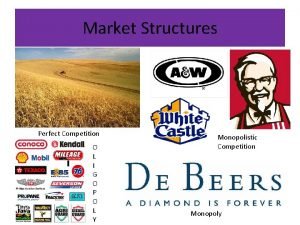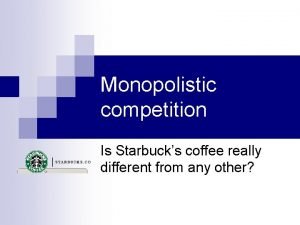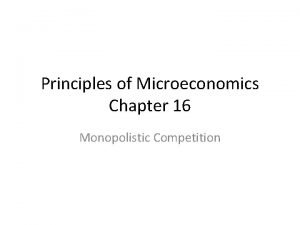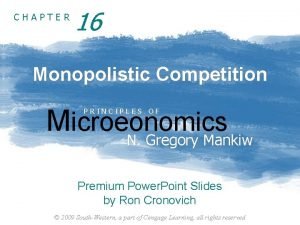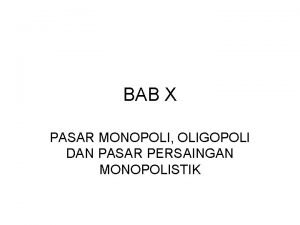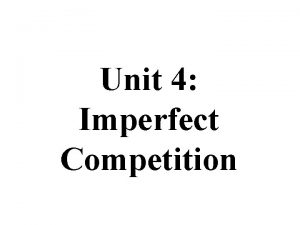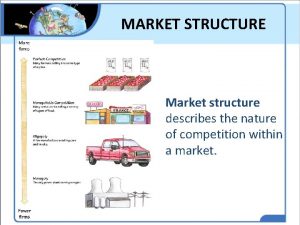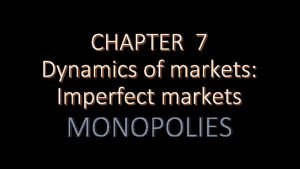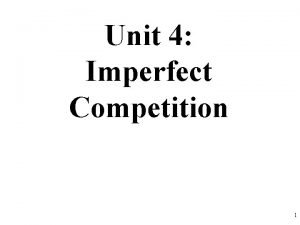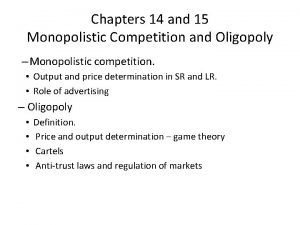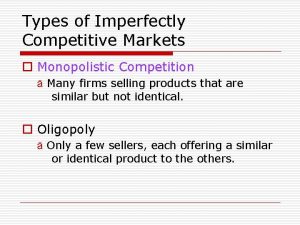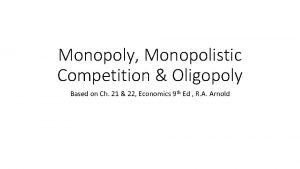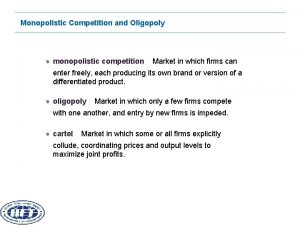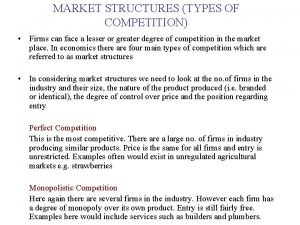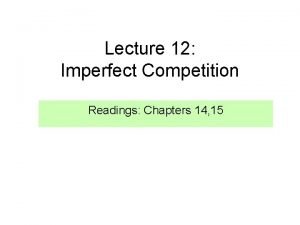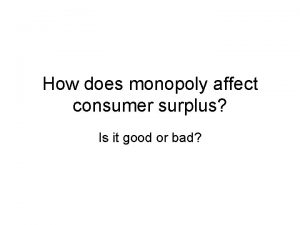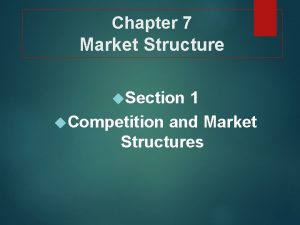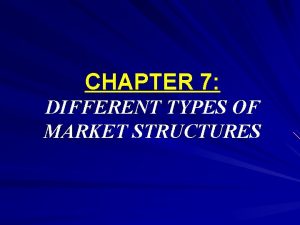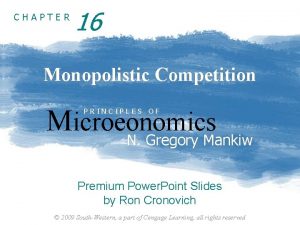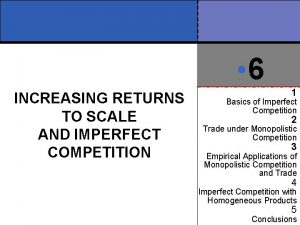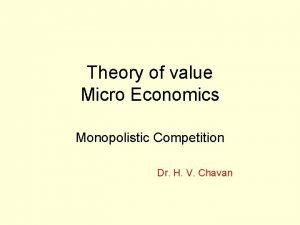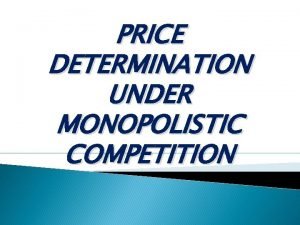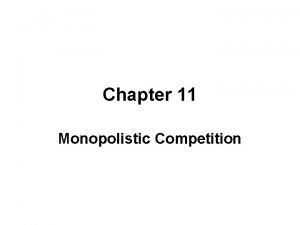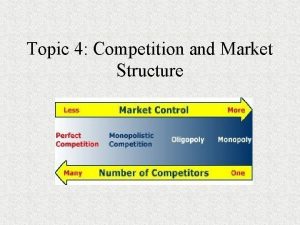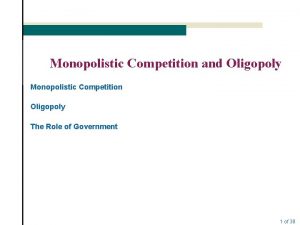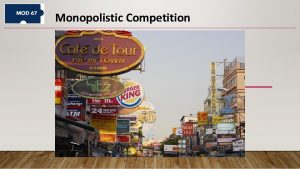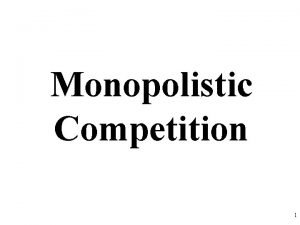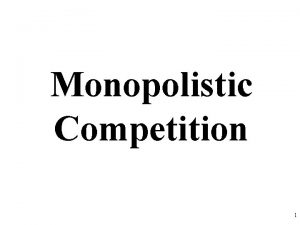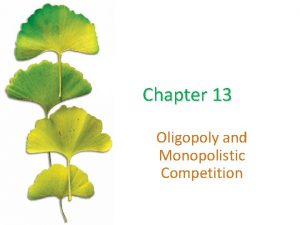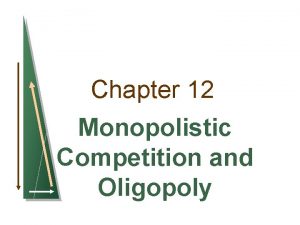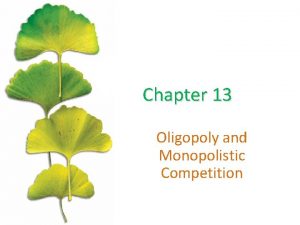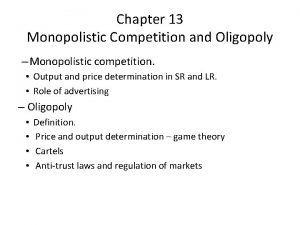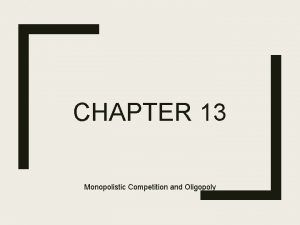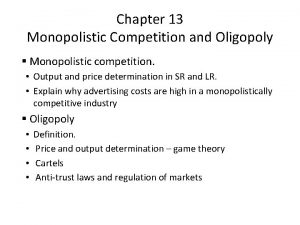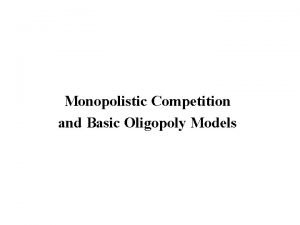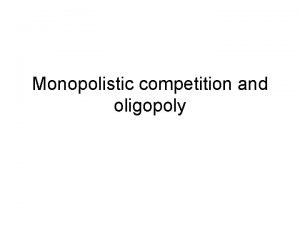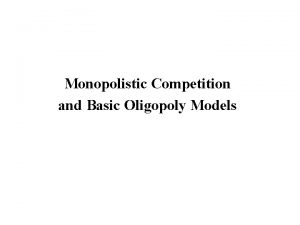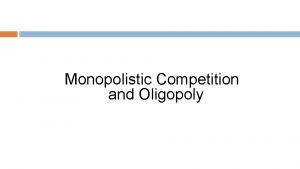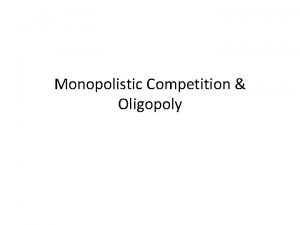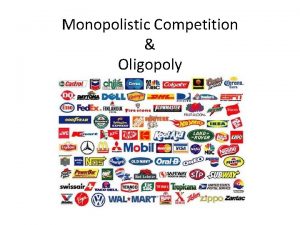Chapter 8 Monopoly Oligopoly and Monopolistic Competition Mc





































- Slides: 37

Chapter 8 Monopoly, Oligopoly, and Monopolistic Competition Mc. Graw-Hill/Irwin © 2009 The Mc. Graw-Hill Companies, All Rights Reserved

Market Imperfections Ch 10 Externalities and Property Rights Ch 8 Imperfect Competition Ch 9 Games and Strategic Behavior LO 8 - All 8 -2

Learning Objectives 1. Distinguish among three types of imperfectly competitive industries 2. Define imperfect competition and describe how it differs from perfect competition 3. Understand why economies of scale are the most enduring source of monopoly power 4. Understand the concepts of marginal cost and marginal revenue § Find the output level and price that maximizes a monopolist's profits 5. Explain why the profit-maximizing output level for a monopolist is too small from society's perspective 6. Discuss why firms offer discounts to buyers who are willing to jump a hurdle LO 8 - All 8 -3

Imperfect Competition § Imperfectly competitive firms have some control of price § Long-run economic profits possible § Reduce economic surplus § Three types 1. Monopoly has only one seller, no close substitutes 2. Monopolistic competition has many firms with differentiated products § These products are all close substitutes 3. Oligopoly is a small number of firms producing close substitutes LO 8 - 2 8 -4

Monopolistic Competition Number of Firms Price Entry and Exit Product Economic Profits Decisions LO 8 - 1 Monopolistic Competition Perfect Competition Many firms Limited flexibility Free Differentiated Price taker Free Standardized Zero in long run P, Q, product differentiation Q only 8 -5

Oligopoly Perfect Competition Few firms, each large Many firms Price Some flexibility Price taker Entry and Exit Large size firm Differentiated or standardized Free Number of Firms Product Standardized Economic Profits Possible Zero in long run Decisions P, Q, differentiation, advertising Q only LO 8 - 1 8 -6

The Essential Difference § Market power is the firm's ability to raise its price without losing all its sales § Any firm facing a downward sloping demand curve § Firm picks P and Q on the demand curve § Market power comes from factors that limit competition Perfectly Competitive Firm Price Imperfectly Competitive Firm D D Quantity LO 8 - 2 Quantity 8 -7

Five Sources of Market Power 1. 2. 3. 4. 5. LO 8 - 3 Exclusive control over inputs Patents and copyrights Government licenses or franchises Economies of scale (natural monopolies) Network economies 8 -8

Market Power: Economies of Scale § Returns to scale refers to the percentage change in output from a given percentage change in ALL inputs § Long-run idea § Constant returns to scale: doubling all inputs doubles output § Increasing returns to scale: output increases by a greater percentage than the increase in inputs § Average costs decrease as output increases § Natural monopoly: a monopoly that results from economies of scale LO 8 - 3 8 -9

Market Power: Network Economies § LO 8 - 3 Network economies occur when the value of the product increases as the number of users increases § VHS format for video tapes, Blu-ray for DVDs § Telephones § Windows operating system § e. Bay § Facebook and My. Space 8 - 10

Economies of Scale and Start-Up Costs § New products can have a large fixed development cost § If marginal cost is constant, Marginal cost = Average variable cost § Total cost is fixed cost (F) plus variable cost TC = F + (M) (Q) § Total cost increases as output increases § Average total cost is ATC = F / Q + M § Average total cost decreases as output increases LO 8 - 3 8 - 11

TC = F + M Q F Average cost ($/unit) Total cost ($/year) Economies of Scale ATC = F/Q + M M Quantity LO 8 - 3 Quantity 8 - 12

Video Game – Different Volumes Nintendo Playstation Annual Production (000 s) 1, 000 1, 200 Fixed Cost ($000 s) $200 Variable Cost ($000 s) $800 $960 Total Cost ($000 s) $1, 000 $1, 160 ATC per game $1. 00 $0. 97 LO 8 - 3 8 - 13

Video Game – Lower Marginal Costs Nintendo Playstation Annual Production (000 s) 1, 000 1, 200 Fixed Cost ($000 s) $200 Variable Cost ($000 s) $200 $240 Total Cost ($000 s) $400 $440 ATC per game $0. 40 $0. 37 LO 8 - 3 8 - 14

Video Games – Higher Fixed Cost Nintendo Playstation Annual Production (000 s) 1, 000 1, 200 Fixed Cost ($000 s) $10, 000 $200 $240 Total Cost ($000 s) $10, 200 $10, 240 ATC per game $10. 20 $8. 53 Variable Cost ($000 s) LO 8 - 3 8 - 15

Video Games – Different Production Levels Nintendo Playstation Annual Production (000 s) 500 1, 700 Fixed Cost ($000 s) $10, 000 $100 $340 Total Cost ($000 s) $10, 100 $10, 240 ATC per game $20. 20 $6. 08 Variable Cost ($000 s) LO 8 - 3 8 - 16

Intel's Advantage § Development cost of a new chip § Marginal cost of making a chip § Dominating the market $2 billion Pennies Priceless § Intel supplies more than 80% of the processors for PCs LO 8 - 3 8 - 17

Monopolist § Pure monopoly: the only seller of a unique product which has no close substitutes § Like all other firms, a monopolist § Maximizes profits § Applies the Cost-Benefit Principle § Increase output if marginal benefit > marginal cost § Decrease output is marginal benefit < marginal cost § Marginal benefit for a monopolist is different than for a perfectly competitor LO 8 - 4 8 - 18

Profit Maximization for the Monopolist Price ($/unit) § For the monopolist, selling one more unit § Decreases market price § Reduces marginal revenue by more than the price § Lower price applied to all units 6 5 D 2 3 Quantity (units/week) LO 8 - 4 8 - 19

Price & marginal revenue ($/unit) Monopolist's Marginal Revenue LO 8 - 4 8 3 D 1 2 -1 3 4 8 5 MR Quantity (units/week) Price Quantity Total Revenue $6 2 $12 Marginal Revenue $5 3 $15 3 $4 4 $16 1 $3 5 $15 -1 8 - 20

Monopoly Demand Marginal Revenue § In general, the monopolist's marginal revenue curve § Has the same intercept as demand § Has twice the slope of demand § Lies below demand Price a a/2 D MR Q 0/2 Quantity LO 8 - 4 8 - 21

Deciding Quantity LO 8 - 4 6 Price ($/unit of output) § A monopolist knows his demand marginal revenue curves § Marginal cost is also known § If he operates at P = $3 and Q = 12, MC > MR § Decrease output § If the firm operates at Q = 8, then MC = MR = 2 § The demand curve sets the price, P = $8 § At any output below 8, MC < MR MC 4 3 D 2 MR 12 8 Quantity (units/week) 8 - 22

Monopoly Losses and Profits Economic profit = $400, 000/day Price ($/minute) 0. 12 ATC 0. 10 MC 0. 05 MR 0. 10 0. 08 ATC MC 0. 05 D 20 24 Minutes (millions/day) LO 8 - 4 Price ($/minute) Economic loss = $400, 000/day MR D 20 24 Minutes (millions/day) 8 - 23

The Invisible Hand Fails Price ($/unit of output) 6 The monopolist's optimal amount occurs where MC = MR, Q = 8 units and P = $4 4 Deadweight loss from monopoly = $4 The socially optimal amount occurs where MC = MB, Q = 12 units and P = $3 3 2 Marginal Cost MR D 8 12 24 Quantity (units/week) LO 8 - 5 8 - 24

Monopoly and Perfect Competition LO 8 - 5 Monopoly Perfect Competition MC = MR P >MR P = MR P > MC P = MC Deadweight Loss No Deadweight Loss 8 - 25

Managing Monopoly § Monopolies exist for economic reasons § Patents, copyrights, and innovation § Economies of scale § Network economies § Anti-trust laws attempt to limit deadweight loss § Limiting monopolies has costs § Patents encourage innovation § Economies of scale minimize ATC § Network economies increase benefits LO 8 - 5 8 - 26

Price Discrimination § Price discrimination means charging different buyers different prices for essentially the same good or service § Separate the groups § No side trades among buyers § Many forms of price discrimination § Hurdle method: discounts for identifiable groups (e. g. , students, AARP) § Perfect discrimination: negotiate separate deals with each customer LO 8 - 6 8 - 27

Carla the Editor What is the social optimum? What's Carla's revenue? § Opportunity cost of Carla's time is $29 Student Reservation Price Total Revenue A B C D E F G $40 38 36 34 32 30 28 $40 $76 $108 $136 $160 $180 $196 LO 8 - 6 8 - 28

Carla the Editor What if Carla What's Carla's maximizes her profit? revenue? § Opportunity cost of Carla's time is $29 Student A B C D E F G LO 8 - 6 Reservation Price Total Revenue $40 38 36 34 32 30 28 $40 $76 $108 $136 $160 $180 $196 MR $40 $36 $32 $28 $24 $20 $16 8 - 29

What's Carla's What if Carla is Carla the Editor perfect discriminator? revenue? § Opportunity cost of Carla's time is $29 Student Reservation Price Total Revenue A B C D E F G $40 38 36 34 32 30 28 $40 $78 $114 $148 $180 $210 $238 LO 8 - 6 8 - 30

Carla Offers a Rebate § If reservation price < $36, mail in rebate Reservation Price Total Revenue A $40 B 38 76 C 36 108 Student Discounted Price Submarket LO 8 - 6 D $34 E 32 64 F 30 90 MR $40 36 32 $34 30 26 8 - 31

Carla's Choices Program Social Optimum Single Price Perfect Discriminator Hurdle Papers Edited 6 3 6 5 = (3 + 2) Price $30 $36 Reservation $36, $4 rebate Total Revenue $180 $108 $210 $172 Carla's Time $174 $87 $174 $145 Economic Profit $6 $21 $36 $27 Total Surplus $26 $27 $36 $35 LO 8 - 6 8 - 32

Hurdle Method of Price Discrimination § The hurdle method of price discrimination is the practice of offering a discount to all buyers who overcome some obstacle. § Temporary Sales § Hard cover and paperback books § Multiple car models from one manufacturer § Commercial air carriers § Movie producers and phased releases § Scratch and Dent appliance sales LO 8 - 6 8 - 33

Imperfect Competition Monopolistic Competition and Oligopoly Sources of Market Power Monopoly LO 8 - All 8 - 34

Chapter 8 Appendix The Algebra of Monopoly Maximization Mc. Graw-Hill/Irwin © 2009 The Mc. Graw-Hill Companies, All Rights Reserved

From Demand to Marginal Revenue § Given a demand curve such as P = 15 – 2 Q § We can write the marginal revenue curve as MR = 15 – 4 Q § Suppose marginal cost is a line with zero intercept and a slope of 1 MC = Q § The remaining step is to set marginal revenue equal to marginal cost LO 8 - 4 8 - 36

MR = MC § Let Q* be the profit maximizing level of output MC = MR Q* = 15 – 4 Q* 5 Q* = 15 Q* = 3 § To find P, substitute Q = 3 into the demand equation P = 15 – 4 Q* P = 15 – 4 (3) P = 3 LO 8 - 4 8 - 37
 Chapter 7 section 3 monopolistic competition and oligopoly
Chapter 7 section 3 monopolistic competition and oligopoly Difference between monopoly and perfect competition
Difference between monopoly and perfect competition Starbucks monopoly
Starbucks monopoly Fast food oligopoly or monopolistic competition
Fast food oligopoly or monopolistic competition Difference between monopoly and monopolistic competition
Difference between monopoly and monopolistic competition Example of pure competition
Example of pure competition Monopoly vs monopolistic competition
Monopoly vs monopolistic competition Characteristics of monopoly
Characteristics of monopoly Pure competition vs monopolistic competition venn diagram
Pure competition vs monopolistic competition venn diagram Competition refers to
Competition refers to Chapter 16 monopolistic competition
Chapter 16 monopolistic competition Characteristics of monopolistic competition
Characteristics of monopolistic competition Monopolistic competition in long run
Monopolistic competition in long run Kurva pasar monopoli
Kurva pasar monopoli Monopoly vs oligopoly venn diagram
Monopoly vs oligopoly venn diagram Market structure
Market structure Difference between monopolistic and perfect competition
Difference between monopolistic and perfect competition Advantages of monopolistic competition
Advantages of monopolistic competition Barriers of entry for oligopoly
Barriers of entry for oligopoly Non price competition in oligopoly
Non price competition in oligopoly What is excess capacity in monopolistic competition
What is excess capacity in monopolistic competition Monopolistic competition characteristics
Monopolistic competition characteristics Price output determination under monopolistic competition
Price output determination under monopolistic competition Consumer surplus in monopolistic competition
Consumer surplus in monopolistic competition Monopolistic competition short run
Monopolistic competition short run Imperfect competition curve
Imperfect competition curve Monopolistic competition in long run
Monopolistic competition in long run Monopolistic competition short run
Monopolistic competition short run How does monopoly affect consumer surplus
How does monopoly affect consumer surplus Monopolistic competition examples
Monopolistic competition examples Monopolistic competition example
Monopolistic competition example Monopolistic competition characteristics
Monopolistic competition characteristics Monopolistic competition
Monopolistic competition Monopolistic competition short run
Monopolistic competition short run How is price determined under monopolistic competition
How is price determined under monopolistic competition Monopolistic competition feature
Monopolistic competition feature Monopolistic def
Monopolistic def Conclusion of monopolistic competition
Conclusion of monopolistic competition

